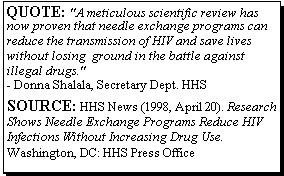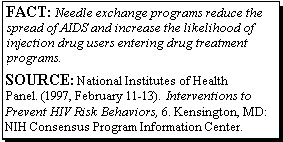
OBJECTIVE: REDUCE THE SPREAD OF INFECTIOUS DISEASE
 Rationale: As surprising as it may seem, many criminal laws to control
drug use actually work against vital public health goals, such as the suppression of
AIDS/HIV and Hepatitis-C. Clearly, any policy that sacrifices the health and well being
of the entire community by spreading deadly communicable diseases in an effort to
“send the right message” needs to be amended so that it does not cause greater
damage to society than the drug use itself.
Rationale: As surprising as it may seem, many criminal laws to control
drug use actually work against vital public health goals, such as the suppression of
AIDS/HIV and Hepatitis-C. Clearly, any policy that sacrifices the health and well being
of the entire community by spreading deadly communicable diseases in an effort to
“send the right message” needs to be amended so that it does not cause greater
damage to society than the drug use itself.
Recommendation 1: Repeal all State and Federal laws designed to prevent access to and possession of sterile syringes and injection equipment.53
Needle exchange programs are one of the most effective means of stemming the devastating and costly tide of AIDS and Hepatitis in our communities. Each day, 33 Americans
54 become newly infected with HIV, and 50% of these cases are due to the sharing of contaminated needles. 55 Women and children are even more severely impacted by needle contamination. Ninety (90%) percent of all new AIDS cases in women and in children under 13 for which the exposure group is known are injection related. 56 Each person living with AIDS will need approximately $195,000 in treatment over their lifetime and can potentially infect thousands of other individuals; meanwhile, a clean syringe only costs about eight cents. These needless deaths and costs can be avoided through the use and promotion of needle exchange programs and provision of syringes in pharmacies. Laws which exist to limit the supply of clean needles, simply ensure the proliferation of contaminated needles.
 While opponents claim that needle exchange programs “send the wrong
message,” the U.S. Government has funded seven reports on clean needle
programs for persons who inject drugs, and each of the reports concluded
that clean needle programs reduce HIV transmission and do not increase drug
use. The reports were conducted by the National Commission on AIDS, the
General Accounting Office, the University of California, the Centers for
Disease Control, the National Research Council, the Institute of Medicine,
the Office of Technology Assessment, and the National Institutes of Health
Consensus Panel. In fact, Baltimore's Health Commissioner Peter Bielenson,
has found that instead of “sending the wrong message,” quite the
opposite is true as stated in his testimony before Congress:
While opponents claim that needle exchange programs “send the wrong
message,” the U.S. Government has funded seven reports on clean needle
programs for persons who inject drugs, and each of the reports concluded
that clean needle programs reduce HIV transmission and do not increase drug
use. The reports were conducted by the National Commission on AIDS, the
General Accounting Office, the University of California, the Centers for
Disease Control, the National Research Council, the Institute of Medicine,
the Office of Technology Assessment, and the National Institutes of Health
Consensus Panel. In fact, Baltimore's Health Commissioner Peter Bielenson,
has found that instead of “sending the wrong message,” quite the
opposite is true as stated in his testimony before Congress:
Equally important, the National Institutes of Health have concluded that “individuals in areas with needle exchange programs have an increased likelihood of entering drug treatment programs.”59 Thus, needle exchange programs reduce AIDS and work toward reducing drug abuse.
Recommendation 2: Make prevention and treatment of Hepatitis-C a high public health priority.
Just as with the emergence of HIV, which was spread in part by the sharing of needles, a newly recognized strain of Hepatitis, known as Hepatitis-C Virus (HCV) is rapidly emerging as a major blood-borne disease. According to the Centers for Disease Control and Prevention, “HCV infection is a major cause of chronic liver disease in the United States and worldwide. At least 85% of persons with HCV infection become chronically infected and chronic liver disease with persistently elevated enzymes develops in approximately 70% of all HCV infected persons.”
60 Unlike the inexpensive intervention of decriminalizing needle possession, the CDC says “the estimated cost for each [infected] person for a 6-month course of therapy is $200,000.”61 In 1998, it was estimated that approximately 4,000,000 Americans were infected with Hepatitis-C. The cost and devastation that will be caused by this epidemic can be greatly reduced through a strong and effective education campaign, combined with outreach to at-risk populations and access to sterile syringes. There is also a need for drug users to have access to medical care, accurate information about the possibility of disease progression once infected, an all out effort for a cure and for drug users to be included in developing new therapeutic interventions.
53 H.R. 2212, HIV Prevention Outreach Act, was introduced by
Rep. Cummings (D-MD) with 7 co-sponsors on July 22nd, 1997. This bill would
have required the Secretary of Healthand Human Services to make grants to
"States and political subdivisions of States" for needle exchange
programs.
54 AIDS Official Backs Needle Exchange. (March 27, 1996).
Associated Press. Quoting the Director, Office of National AIDS Policy Sandra
Thurman at a National AIDS UPDATE Conference.
55 Holmberg, S. (1996). "The Estimated Prevalence and Incidence of HIV
in 96 Large US Metropolitan Areas." American Journal of Public Health,
86, 642-54.
56 Centers for Disease Control. HIV/AIDS Surveillance Report. HIV
and AIDS Cases Reported through December 1997. Year-end edition, Vol. 9,
No. 2.
57 Holtgrave, DR, Pinkerton, SD. "Updates of Cost of Illness and
Quality of Life Estimates for Use in Economic Evaluations of HIV Prevention
Programs." Journal of Acquired Immune Deficiency Syndromes and Human
Retrovirology, Vol. 16, pgs. 54-62 (1997).
58 Bielenson, MD, Peter. (1997, September 18). Written testimony of Dr.
Bielenson to Subcommittee on National Security, International Affairs and
Criminal Justice.
59 National Institutes of Health Consensus Panel. (1997, February
11-13). Interventions to prevent HIV risk behaviors, 6. Kensington, MD:
NIH Consensus Program Information Center.
60 Centers for Disease Control. Morbidity and Mortality Weekly
Report. (1997, July 4). Vol. 46, No. 26. Atlanta, Georgia.
61 Ibid.